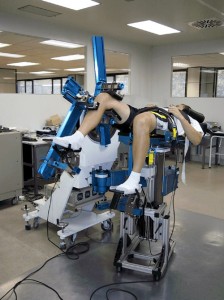Some operations make us nervous because there is not much about we can do about them from ground. The MARES experiment in the Columbus space laboratory is one of these: it is large, highly complex, equipment and can sometimes be a bit of a problem child.
The Muscle Atrophy Research and Exercise system (MARES) allows us to investigate muscle groups of astronauts and contributes to answering essential questions that arise during long space flights: how does the human body react to weightlessness? How fast to muscles degrade when they are not used in weightlessness?

Muscle Atrophy Research and Exercise System (MARES). Credits: ESA
We think of MARES as a bit of a monster as it fills half of the Columbus module –it takes a while to unpack so each experiment involving MARES takes a long time, afterwards it must be disassembled again. It looks a little like the torture devices that can be found in many fitness centres – this might explain why the flight controllers have so much respect for the machine. It is a mechanically very complex device and any problems astronauts have encountered in the past have proven difficult to solve over the radio…
So it was with a sigh of relief on my part that I was not on console when this was planned to be setup: many hours of astronaut crew time are designated in the timeline to work on MARES. I got nervous again when a colleague fell sick and I had to take over after all …
Ultimately, of course my colleagues and ESA astronaut Samantha Cristoforetti did excellent work: they had to replace a battery (a machine of this size requires more power than Columbus can provide on its own), install a new hard drive and finally test the device for the first time in orbit through by calibrating its servo-motors.
The machine was then put back where every monster belongs, in its “cage”, an experiment cabinet in Columbus – until next time…!
Thomas Uhlig
Columbus Control Centre
[youtube zpAfrbYtTOs]
Cover picture: Only in Space recommended: four years ago MARES was installed in Columbus – Astronaut Doug Wheelock and proves prowess …
(Credits: NASA)
27/03/2015




